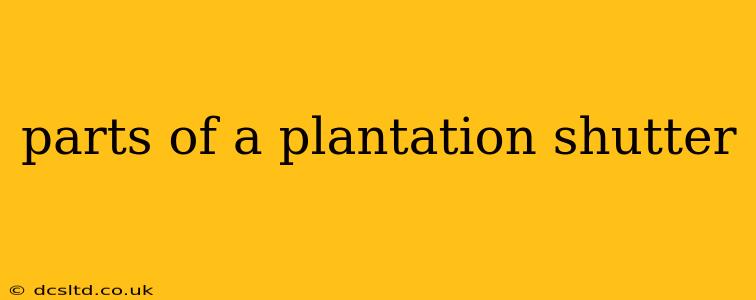Plantation shutters, known for their timeless elegance and superior light control, are more than just window coverings. They are a statement piece, adding both style and functionality to any home. But understanding their components can help you appreciate their craftsmanship and make informed choices when purchasing or maintaining them. This guide breaks down the essential parts of a plantation shutter, answering common questions homeowners often have.
What are the main parts of a plantation shutter?
The core components of a plantation shutter work together seamlessly to create a beautiful and functional window treatment. These include:
- Louvers: These are the horizontal slats that make up the main body of the shutter. Their size and spacing significantly influence the amount of light and airflow. Wider louvers offer a more modern look, while narrower ones provide more precise light control.
- Frame (or Rail): This is the outer border of the shutter panel, providing structural support and a finished edge. The frame typically incorporates tilt rods and possibly hinges, depending on the shutter type.
- Tilting Mechanism (Tilt Rods): This mechanism allows you to adjust the angle of the louvers, controlling the amount of light entering the room. Different mechanisms exist, from simple control rods to more sophisticated systems that allow for centralized control.
- Hinges: These connect the shutter panels to the window frame, allowing them to swing open and closed. Their quality and placement are crucial for smooth operation.
- Panel (or Shutter Panel): This refers to the entire assembled unit of louvers, frame, and hinges. Multiple panels are often used for wider windows.
- Decorative Capping (Optional): Some shutters include decorative capping along the top and bottom of the panel, adding a touch of elegance and refinement.
What are plantation shutter panels made of?
Plantation shutter panels are typically crafted from either wood or a composite material. Wood shutters, such as those made from basswood or poplar, offer a classic, luxurious look and feel, but require more maintenance. Composite materials, often incorporating PVC or other polymers, are more durable, moisture-resistant, and require less upkeep.
How do the louvers work in plantation shutters?
The louvers are the heart of a plantation shutter's light-controlling abilities. They are connected by the tilting mechanism, which allows you to adjust their angle. Closing the louvers completely blocks out light, while opening them allows for varying degrees of sunlight and ventilation.
What are the different types of plantation shutters?
Plantation shutters are available in various styles, including:
- Full Height Shutters: These extend from the window frame to the sill, offering maximum coverage and privacy.
- Café Style Shutters: These cover only the bottom portion of the window, allowing light to enter from the top while maintaining privacy below.
- Tier-on-Tier Shutters: These are two separate shutters stacked on top of each other, offering independent control over upper and lower sections of the window.
How much do plantation shutters cost?
The cost of plantation shutters depends on several factors, including size, material, style, and customization options. Custom-made wood shutters typically represent a higher investment than ready-made composite options.
What is the best material for plantation shutters?
The ideal material depends on your budget, lifestyle, and the specific environment. Wood offers a classic aesthetic and can be stained or painted to match your décor, but needs more care. Composite materials provide durability, water resistance, and low maintenance—ideal for bathrooms or kitchens.
By understanding the components and variations of plantation shutters, you can make an informed decision that best suits your needs and enhances your home's beauty and functionality for years to come. Remember to consider factors like material, style, and budget to find the perfect plantation shutters for your windows.
